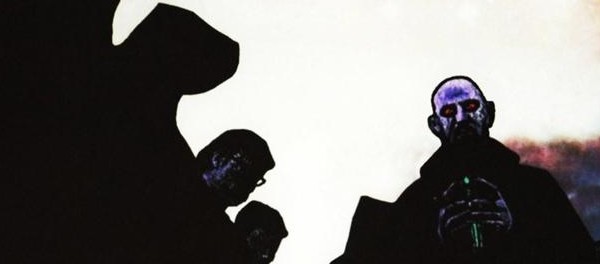The 10 Greatest UK Doom Metal Albums!
Doom metal classics!
 Source // www.nuclearblast.de
Source // www.nuclearblast.de
Doom metal, us Brits have always been bloody good at it.
We invented it, we morphed it into new shapes and the history of UK doom metal is littered with success stories, of pioneering bands that took hold of doom metal’s fundamentals and twisted them into new forms, unearthing all-time classic albums along the way.
While Candlemass, Trouble and Saint Vitus may have threatened to usurp us in the 80’s the arrival of Cathedral, in 1991, turned the tables and, once again, the Brits were back, firmly in charge!
As resolutely British as fish ‘n’ chips and as bleak as our weather, good doom metal is a wonderful thing but these 10 defining moments in UK doom metal history are simply sublime.
Starting with (obviously)….
Black Sabbath – Black Sabbath (1970)
It’s frankly ridiculous to think that on release Black Sabbath was slammed by critics (perhaps not ready for such a departure into darker, more-twisted territories), dismissed as mere clichéd clones of bands such as Cream, Vanilla Fudge and Black Widow. Of course, anything new can be threatening and perhaps the world wasn’t quite ready for this. Hell, it had only just gotten used to the idea of hard rock and Black Sabbath were an entirely different beast altogether!
Make no mistake, when Sabbath released their eponymous debut in 1970 an entirely new genre spewed forth, a genre built on elephantine heaviness, primeval blues roots and faux satanic leanings. Doom metal had arrived and it was ugly, frightening, foreboding and utterly exhilarating.
Cathedral – Forest Of Equilibrium (1991)
:format(jpeg):mode_rgb():quality(90)/discogs-images/R-8205732-1459111415-2786.jpeg.jpg)
Cathedral are a British metal institution and their brand of achingly brutal doom was perfected on their astonishing debut; an album that shook doom metal’s foundations with its monolithic waves of dense, earth-shattering sound and put UK doom firmly back on the map.
Folky, morose and defiantly British, Lee Dorrian and Cathedral took Black Sabbath’s blueprint and slowed…everything…down…to…a…lumbering…crawl. With one foot firmly in the shallow grave of 70’s doom forefathers Pentagram, Bedemon, Necromandus and the aforementioned Sabbath, each colossal track on Forest Of Equilibrium opened new doors for doom and stoner rock to pass through.
From the stoner-grooves of “Soul Sacrifice” to the acoustic strum followed by plodding doom metal murkiness of the stunning “Picture of Beauty & Innocence (Intro)/Commiserating the Celebration” and the equally foreboding “A Funeral Request“, Forest Of Equilibrium remains a monolithically dark experience that has stood the test of time and cemented Cathedral’s place at the forefront of doom metal on release.
Sadly disbanded, perhaps Cathedral will one day reform and revive their doom metal past; they are sorely missed.
Paradise Lost – Gothic (1991)
:format(jpeg):mode_rgb():quality(90)/discogs-images/R-11806908-1527841237-7870.jpeg.jpg)
One album, two genres successfully defined and it was just the start of Paradise Lost’s evolution into becoming one of Britain’s most fearless bands.
Incredibly, Gothic kickstarted the gothic metal sub-genre while Paradise Lost were still in the process of defining death/doom. A two-pronged attack on established tropes, their pioneering use of female vocals, chilling keyboards and Nick Holmes unmistakable death metal roar proved Paradise Lost were leaders in their field and cowered to no one.
Home to many of their most adored compositions, Gothic‘s maturity remains tangible. A group of musicians – led by Gregor MacKintosh’s unmistakable guitar sound – fearlessly venturing into realms unknown and introducing rarely heard melody to doom metal’s genuinely monolithic drone.
Wrap your earholes around “Gothic” and “Eternal” and tell us that sound doesn’t invoke shivers 30 years after its release!
Seventh Angel – Lament For The Weary (1991)
:format(jpeg):mode_rgb():quality(90)/discogs-images/R-3390905-1475753662-2688.jpeg.jpg)
The UK seemed to enjoy experimenting with thrash, often combining seemingly disparate sub-genres to create an entirely new thrash experience. Sabbat and Skyclad incorporated pagan and folk influences, Cerebral Fix and Energetic Krusher embraced death metal while Seventh Angel chose to throw doom metal into the mix….and with astonishing results!
An original sound showcasing the finest moments of doom legends Candlemass and the technical meets traditional heavy metal thrash of Sanctuary, circa Into The Mirror Black, the often impenetrably dark and yet morbidly melancholic sound of Lament For The Weary saw Seventh Angel’s lumbering doom passages merge seamlessly with bursts of aggressive speed; fully ensconced in projecting pain and despair.
Not an easy ride but a rewarding one, Lament For The Weary remains a weighty tome, relentless and remorseless and akin to gourging on the great works of literature. In other words, an album not for the faint-hearted!
A one of a kind album fully deserving of classic status and the finest doom/thrash album ever written.
Decomposed – Hope Finally Died… (1993)
:format(jpeg):mode_rgb():quality(90)/discogs-images/R-1445315-1220280398.jpeg.jpg)
Possibly the most overlooked album in death/doom history – and UK metal in general – Decomposed’s Hope Finally Died… deserves to be mentioned in the same breath as the seminal releases from the Peaceville three (Paradise Lost, My Dying Bride, Anathema) namely Gothic, Turn Loose The Swans and Serenades respectively.
Deceptively simple, the beauty of this staggering release lies not in its musicality, nor its vocal prowess or even its songwriting nous. At face value, all these facets seem relatively generic but the true reason this savagely under-appreciated cornerstone of death/doom deserves higher praise, is down to the almost unparalleled way in which Decomposed blend the mournful melancholy of doom with the caustic and cathartic blur of death metal aggression; each song unearthing a new spin on an already standard formula and expertly fusing sorrowful soliloquay’s with neck-breaking riffs.
Whether primitive old-school death metal savagery or shuffling excursions into doom metal’s swampy territory peels your onions, Decomposed’s one and only full length should be mandatory listening. Unearth its treasures and discover why Hope Finally Died… is not only a hidden gem but also a defining moment in UK doom metal history.

:format(jpeg):mode_rgb():quality(90)/discogs-images/R-3036895-1585279148-1983.jpeg.jpg)








Leave a comment